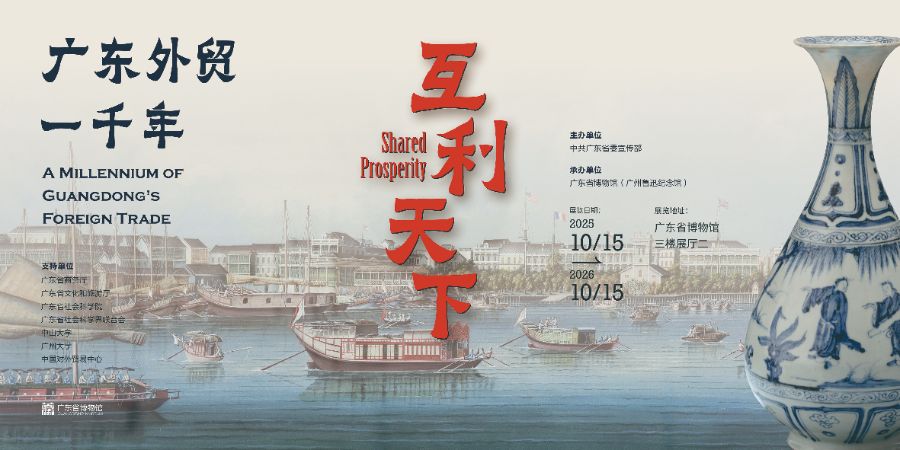“Mutual Benefit to the World: A Millennium of Guangdong Foreign Trade” grand exhibition has opened at the Guangdong Museum, featuring over 200 cultural relics that systematically trace the development of Guangdong’s foreign trade since the Tang Dynasty.
A millennium of commercial heritage, layered with maritime waves.
From the bustling Maritime Trade Offices of the Tang and Song dynasties to the “China’s No. 1 Exhibition” era of the Canton Fair, Guangdong’s foreign trade epic has never ceased. On October 15, the “Mutual Benefit to the World: A Millennium of Guangdong Foreign Trade” grand exhibition, hosted and organized by relevant cultural authorities, opened ceremoniously at the Guangdong Museum.
The exhibition is divided into four major sections, narrating the development and transformation of Guangdong’s foreign trade since the Tang Dynasty and fully presenting its evolution from institutional萌芽 to a global hub. This year-long cultural feast not only brings together over 200 national treasures from the Guangdong Museum and other cultural institutions across the country but also systematically梳理 the development trajectory of Guangdong’s millennium of foreign trade, using profound historical wisdom to illuminate the broad prospects of opening up in the new era.
An expert pointed out that historically, Guangdong’s development of maritime trade had advantages in both transportation and manufacturing foundations. “On one hand, the long coastline, numerous coastal ports, coupled with the deep waters of the South China Sea and no freezing period year-round, give it unparalleled navigation conditions nationwide.”
On the other hand, kilns from the Tang and Song periods, as well as Guangdong embroidery and Canton porcelain from the Ming and Qing dynasties, provided abundant commodity resources for the prosperity of foreign trade. “It can be said that Guangdong has inherently possessed the triple advantage of ‘production, transportation, and sales’ in foreign trade since ancient times, and its status as the top foreign trade province today is the result of a millennium of accumulation.” By 2024, Guangdong’s total foreign trade import and export volume exceeded 9 trillion yuan for the first time, ranking first in the country for 39 consecutive years.
On the same day, the 138th Canton Fair opened in Guangzhou. Up to now, this session of the Canton Fair has attracted over 240,000 purchasers from 218 countries and regions, with pre-registration increasing by 10%. The bustling crowds in the Canton Fair exhibition hall and the historical artifacts in the museum intertwine, demonstrating the confidence in openness of Guangdong, the nation’s top foreign trade province. An expert stated that the greater significance of the Canton Fair today lies in building a platform that facilitates more international economic and trade cooperation through information exchange. “Cooperation at the Canton Fair originates in Guangdong but extends beyond it; the execution scope of its transactions can cover the entire country and even the globe, which also highlights Guangdong’s position in the global trade network in the new era.”
“Guangdong’s Positioning” in the Global Trade Network
“Guangdong has always been at the forefront of China’s opening up. The port trading conditions formed over a millennium and the gradual development of foreign trade, especially the rapid development since the reform and opening up, have also made the Guangdong-Hong Kong-Macao Greater Bay Area a center of global trade,” an expert noted.
After the founding of New China, Guangdong, leveraging its geographical advantages and overseas Chinese capital base, continued to play a key role in the country’s opening up. In the exhibition section “Tides of a New Chapter,” visitors can see Guangdong’s foreign trade leap from “breaking the ice” to “leading” through the historical context of the Canton Fair and the innovative practices of pilot free trade zones.
“From the first session to now, the Canton Fair’s export turnover has increased more than 200-fold,” summarized an expert, capturing the glorious achievements of the Canton Fair over more than half a century.
Born in 1957, the Canton Fair, as a “barometer” and “wind vane” of China’s foreign trade, has been held for 138 consecutive sessions without interruption. An expert stated, “Especially in the early days of New China, when channels for foreign exchanges were not particularly abundant, the orders from the biannual Canton Fair accounted for a significant proportion of the annual export orders.” Transitioning from primarily exporting small commodities, grains, oils, and native produce in its early days to focusing on mechanical and electrical products and high-tech products, the changes in the Canton Fair’s exhibits also reflect the trajectory of China’s industrial upgrading and foreign trade transformation.




